
William Cuthbert Faulkner was an American writer known for his novels and short stories set in the fictional Yoknapatawpha County, based on Lafayette County, Mississippi, where Faulkner spent most of his life. Faulkner is one of the most celebrated writers of American literature, and is widely considered one of the best writers of Southern literature.
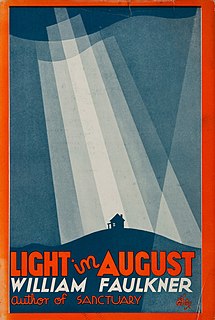
Light in August is a 1932 novel by the Southern American author William Faulkner. It belongs to the Southern gothic and modernist literary genres.

The Sound and the Fury is a novel by the American author William Faulkner. It employs several narrative styles, including stream of consciousness. Published in 1929, The Sound and the Fury was Faulkner's fourth novel, and was not immediately successful. In 1931, however, when Faulkner's sixth novel, Sanctuary, was published—a sensationalist story, which Faulkner later said was written only for money—The Sound and the Fury also became commercially successful, and Faulkner began to receive critical attention.

Yoknapatawpha County is a fictional Mississippi county created by the American author William Faulkner, largely based upon and inspired by Lafayette County, Mississippi, and its county seat of Oxford. Faulkner often referred to Yoknapatawpha County as "my apocryphal county".
Louis Grenier is a fictional character in William Faulkner's novels and stories.

As I Lay Dying is a 1930 Southern Gothic novel by American author William Faulkner. Faulkner's fifth novel, it is consistently ranked among the best novels of 20th-century literature. The title derives from Book XI of Homer's Odyssey, wherein Agamemnon tells Odysseus, "As I lay dying, the woman with the dog's eyes would not close my eyes as I descended into Hades."

Cleanth Brooks was an American literary critic and professor. He is best known for his contributions to New Criticism in the mid-20th century and for revolutionizing the teaching of poetry in American higher education. His best-known works, The Well Wrought Urn: Studies in the Structure of Poetry (1947) and Modern Poetry and the Tradition (1939), argue for the centrality of ambiguity and paradox as a way of understanding poetry. With his writing, Brooks helped to formulate formalist criticism, emphasizing "the interior life of a poem" and codifying the principles of close reading.

Sanctuary is a 1931 novel by American author William Faulkner about the rape and abduction of an upper-class Mississippi college girl, Temple Drake, during the Prohibition era. The novel was Faulkner's commercial and critical breakthrough and established his literary reputation, but was controversial given its themes. It is said Faulkner claimed it was a "potboiler", written purely for profit, but this has been debated by scholars and Faulkner's own friends.

William Clark Falkner was a soldier, lawyer, politician, businessman, and author in northern Mississippi. He is most notable for the influence he had on the work of his great-grandson, author William Faulkner.
"Barn Burning" is a short story by the American author William Faulkner which first appeared in Harper's in June 1939 and has since been widely anthologized. The story deals with class conflicts, the influence of fathers, and vengeance as viewed through the third-person perspective of a young, impressionable child. It precedes The Hamlet, The Town, and The Mansion, the three novels that make up Faulkner's Snopes trilogy.

The Hamlet is a novel by the American author William Faulkner, published in 1940, about the fictional Snopes family of Mississippi. Originally a standalone novel, it was later followed by The Town (1957), and The Mansion (1959), forming the "Snopes trilogy."
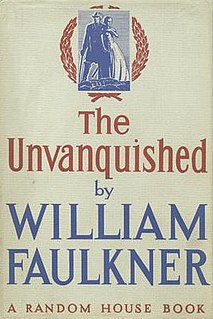
The Unvanquished is a 1938 novel by the American author William Faulkner, set in the fictional Yoknapatawpha County. It tells the story of the Sartoris family, who first appeared in the novel Sartoris. The Unvanquished takes place before that story, and is set during the American Civil War. Principal characters are Bayard Sartoris, John Sartoris, Granny, Ringo (Morengo), Ab Snopes, Cousin Drusilla, Aunt Jenny, Louvinia, and the lieutenant.
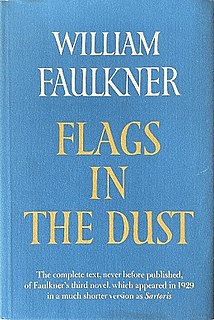
Flags in the Dust is a novel by the American author William Faulkner, completed in 1927. His publisher heavily edited the manuscript with Faulkner's reluctant consent, removing about 40,000 words in the process. That version was published as Sartoris in 1929. Faulkner's original manuscript of Flags in the Dust was published in 1973, and Sartoris was subsequently taken out of print.
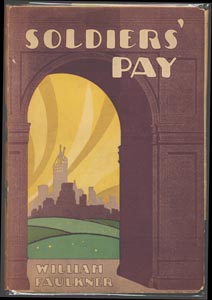
Soldiers' Pay is the first novel published by the American author William Faulkner. It was originally published by Boni & Liveright on February 25, 1926. It is unclear if Soldiers' Pay is the first novel written by Faulkner. It is however the first novel published by the author. Faulkner was working on two manuscripts while finishing Soldiers' Pay.

The Town is a novel by the American author William Faulkner, published in 1957, about the fictional Snopes family of Mississippi. It is the second of the "Snopes" trilogy, following The Hamlet (1940) and completed by The Mansion (1959).
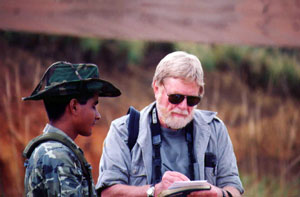
Douglas Turner Day III was an American novelist, biographer, scholar and critic. He was a popular professor of English literature at the University of Virginia, where he taught almost four decades.

The Waste Land is a poem by T. S. Eliot, widely regarded as one of the most important poems of the 20th century and a central work of modernist poetry. Published in 1922, the 434-line poem first appeared in the United Kingdom in the October issue of Eliot's The Criterion and in the United States in the November issue of The Dial. It was published in book form in December 1922. Among its famous phrases are "April is the cruellest month", "I will show you fear in a handful of dust", and the mantra in the Sanskrit language "Shantih shantih shantih".
Maurice-Edgar Coindreau was a literary critic and translator of fiction from English into French and Spanish. He is notable for having introduced many canonical American authors of the 20th century—such as William Faulkner, John Dos Passos, John Steinbeck, and Ernest Hemingway—to the French-speaking public.
Knight’s Gambit is a 1949 short story collection by the American author William Faulkner, and contains a short story of the same name. The book collects six of Faulkner’s stories about attorney Gavin Stevens, who also takes a leading part in his novel Intruder in the Dust.

Dean Faulkner Wells was an American author, editor, and publisher.
















